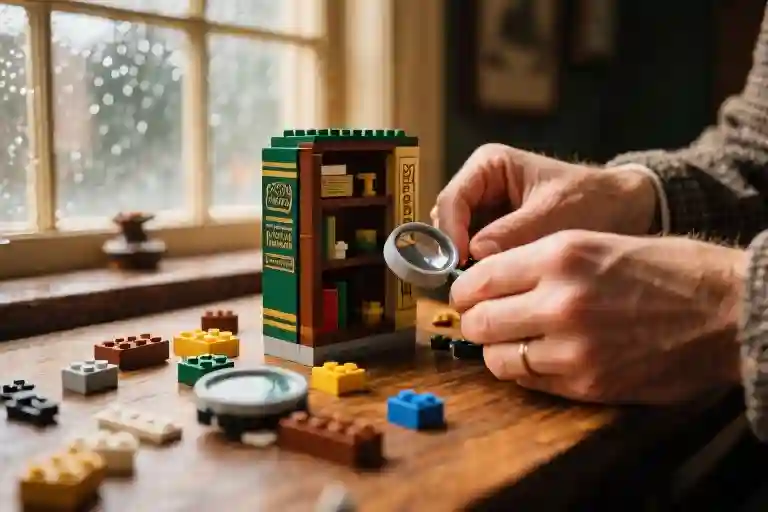There’s a particular kind of exhaustion that settles in your bones when every podcast, every Instagram reel, every well-meaning friend’s advice becomes another reminder that you’re not quite finished yet. You’re the construction project, and the world keeps sending contractors with new blueprints for your life.
Wake up earlier. Journal more. Work out harder. Drink more water. Manifest. Meditate. Grind.
The chorus never stops, does it? It’s like living in a house where someone’s always remodeling, but the construction never finishes. You start wondering when you’ll get to just live in the home instead of constantly repairing it.
Self-improvement has become our new religion. We bow at the altar of “better”—better body, better job, better mindset, better everything. The hymns are productivity podcasts, the scriptures are self-help books, and the communion is another green smoothie that promises enlightenment. But somewhere between the fifth productivity hack and the third meditation app, I realized something: this temple we’re building has no doors, no windows, and no way out.
Here’s what I wish someone had told me years ago: You don’t need fixing. You’re not a busted sink waiting for a plumber or an outdated iPhone desperate for a software update. You’re a human being—complex, messy, beautiful, and already whole.
The most radical thing you can do in a world obsessed with improvement is to stop treating yourself like a broken product that needs endless patches. Instead of trying to become someone else’s version of better, what if we tried something different? Something that doesn’t leave us exhausted? Something that actually feels like living?
I’ve found three alternatives that work better than any self-improvement program I’ve tried. They don’t cost money, don’t require special equipment, and won’t make you feel like you’re failing if you miss a day. They’re simple, human, and available right now.
Connect Instead of Correct
A friend’s confession still echoes in my mind: “I don’t need another productivity hack. I just need someone to text me back.” That simple, raw admission captures the quiet desperation so many of us feel—a longing not for optimization, but for presence.
We inhabit the most technologically connected age in human history, yet loneliness has become a silent epidemic. According to the U.S. Surgeon General, chronic loneliness carries mortality risks comparable to smoking 15 cigarettes daily. The data is startling, but the feeling is even more profound: a hollow ache that no amount of scrolling, liking, or consuming can fill.
And here’s where the self-improvement narrative fails us spectacularly. We’ve been sold the idea that connection is something we earn—by becoming smarter, fitter, richer, more enlightened. We treat loneliness as a personal shortcoming, something to be fixed with better habits, a more attractive profile, or a more impressive bio. But loneliness isn’t a character flaw. It’s not a bug in your system. It’s a signal—a sign that we’re starving for what technology can’t provide: authentic, embodied human contact.
When you believe you must become “better” to deserve love and belonging, you enter a cage of perpetual self-correction. You postpone connection until you’re worthy of it. You withhold your presence until you’ve optimized your personality, your body, your career. But that day never comes, because the goalposts of “better” are always moving.
The alternative isn’t another set of relationship hacks or social strategies. It’s a shift in intention: from correcting yourself to connecting with others. It means picking up the phone without rehearsing what you’ll say. It means asking a real question and listening to the answer without mentally drafting your response. It means looking someone in the eye and allowing yourself to be seen, exactly as you are.
Real connection is messy and unscripted. It doesn’t require you to be perfect—it requires you to be present. And in that presence, something unexpected happens: you remember that you’re already enough. You don’t need to earn your place in someone’s attention. You just need to show up.
This isn’t about networking or expanding your social circle. It’s about depth, not breadth. One real conversation—where vulnerabilities are shared and masks are set aside—can do more for your sense of belonging than a year of self-improvement podcasts.
So try this: instead of trying to fix your way out of loneliness, connect your way through it. Text a friend just to say you’re thinking of them. Invite someone for a walk without an agenda. Tell someone what you’re actually struggling with, not what you think you should be struggling with.
Connection isn’t the reward for becoming a better version of yourself. It’s the very thing that makes you feel human again. And sometimes, healing begins not with a solution, but with a simple, honest hello.
Rest Instead of Race
Raise your hand if you’ve ever proudly announced how little sleep you got last night. We’ve all done it—treated exhaustion like some sort of productivity badge, as if burning out were an Olympic sport. “I only slept four hours” has become the modern equivalent of “look how dedicated I am,” when what it really means is “I’m running on empty and pretending it’s a virtue.
This cultural worship of busyness has turned rest into something we have to earn rather than a biological necessity. We’ve created this bizarre hierarchy where the most sleep-deprived person wins some imaginary prize for suffering. But here’s what nobody tells you: exhaustion isn’t an achievement. It’s just exhaustion.
Sleep scientist Dr. Matthew Walker’s research shows that sleep is “the single most effective thing we can do to reset our brain and body each day.” His studies at UC Berkeley reveal that sleep deprivation impairs everything from memory consolidation to immune function. When you’re running on insufficient rest, you’re essentially trying to bake a cake with half the ingredients—it might still resemble a cake, but it won’t taste right or nourish anyone properly.
Yet we keep pushing, fueled by the mistaken belief that productivity means constant motion. We drink another coffee, set another alarm, download another productivity app—anything to avoid facing the truth that what we might need isn’t another hack, but simply to close our eyes.
The irony is that being sleep-deprived makes you worse at everything you’re trying to improve. That focus you want? Diminished. The creativity you’re chasing? Dormant. The emotional regulation you need? Compromised. You’re trying to build a better life with tools that are fundamentally broken because you won’t let them recharge.
Perhaps the most radical thing you can do for your self-improvement isn’t adding another activity, but subtracting the constant pressure to be productive. Rest isn’t laziness—it’s strategic recovery. It’s what allows everything else to work properly.
So how do we actually rest in a world that screams otherwise? Start by reframing rest as active rather than passive. Quality rest isn’t just about sleeping—it’s about intentional recovery. That might mean:
- Setting digital boundaries an hour before bed
- Taking actual lunch breaks away from your desk
- Scheduling downtime like you would meetings
- Recognizing that rest looks different for everyone—maybe it’s reading, walking, or simply staring at clouds
European cultures have long embraced the concept of siesta, while Japanese companies are introducing in-office nap pods. These aren’t signs of laziness but recognition that rested employees are more innovative, focused and productive. The science backs this: NASA found that a 26-minute nap improved pilot performance by 34% and alertness by 54%.
Your body isn’t a machine that can run continuously without maintenance. Even the most advanced technology needs downtime for updates and repairs. Why would humans be any different?
Tonight, instead of scrolling through one more productivity podcast or researching the perfect morning routine, try this: go to bed thirty minutes earlier. Don’t set an alarm for the morning (if your schedule allows). See how you feel when you wake naturally. Notice the difference in your mental clarity, your patience, your ability to handle challenges.
Rest isn’t the enemy of achievement—it’s the foundation. You can’t build anything lasting on fractured ground. The constant racing toward some idealized version of yourself might actually be preventing you from becoming who you already are: a human being who needs rest, deserves rest, and functions better with rest.
Maybe the ultimate productivity hack isn’t doing more, but resting better. And perhaps the most rebellious act in our achievement-obsessed culture is to simply lie down and close your eyes.
Create Instead of Criticise
We live in an age of relentless self-evaluation, where every mirror reflects not just our face but a checklist of flaws. The inner critic that lives in our heads didn’t appear by accident—it’s been carefully cultivated by a culture that profits from our dissatisfaction. Social media feeds us endless comparisons, advertising whispers that we’re incomplete, and the entire wellness industry builds its empire on the foundation of our perceived inadequacies.
This constant criticism isn’t just unpleasant; it’s exhausting. It drains creative energy, diminishes joy, and keeps us trapped in cycles of self-improvement that never actually lead to self-acceptance. The critic tells us we must be better before we can create, that our art isn’t good enough, our writing isn’t profound enough, our cooking isn’t Instagram-worthy enough. So we don’t create. We just criticise.
But here’s the secret the self-improvement industry doesn’t want you to know: creating is the antidote to criticising. When your hands are busy making something—anything—your mind has less capacity to tear you down. There’s something almost magical about the act of creation that silences the inner critic, not through force but through gentle distraction.
The science behind this is fascinating. Creative activities engage what neuroscientists call the “default mode network”—the part of our brain that activates during daydreaming and spontaneous thought. This mental state is associated with reduced anxiety, improved mood, and even enhanced problem-solving abilities. When we’re immersed in creating, we enter a flow state where self-consciousness diminishes and pure being takes over.
My aunt’s story illustrates this perfectly. For years, she battled body image issues, jumping from diet to diet, each failure amplifying her self-criticism. Then she did something radical: instead of trying to change her body, she started drawing it. Not perfect magazine illustrations, but honest sketches in a cheap notebook. At first, the critic protested—”You’re not an artist,” “Those lines are all wrong.” But she kept drawing. And slowly, something shifted. The act of creation began to override the impulse to criticise. She started seeing her body not as a collection of flaws but as a subject worthy of artistic attention. The drawings weren’t masterpieces, but they became something more important: medicine.
This transformation isn’t unique to my aunt. Research shows that creative expression significantly reduces stress hormones, improves mood, and even boosts immune function. A study published in the Journal of Positive Psychology found that people who engage in daily creative activities report higher levels of enthusiasm and “flourishing” compared to those who don’t. The beauty of creative healing is that it doesn’t require talent—it only requires engagement.
The possibilities for everyday creation are endless and accessible to everyone. Cooking a meal from scratch, planting herbs in a windowsill pot, arranging flowers, writing a letter by hand, knitting a simple scarf, organizing photos into an album, even coloring in an adult coloring book—all these acts count as creation. The value isn’t in the outcome but in the process itself.
I’ve started keeping what I call a “creation log”—a simple notebook where I jot down one creative act I performed each day. Some days it’s “made soup from vegetables that needed using” or “rearranged the bookshelf by color.” Other days it’s “wrote three paragraphs that will never be published” or “drew silly cartoons in the margin of my meeting notes.” The log isn’t about quality; it’s about reminding myself that I am someone who creates, not just someone who criticises.
The shift from critic to creator changes everything. Where criticism isolates, creation connects—to materials, to process, to the physical world. Where criticism judges, creation accepts—imperfect lines, uneven stitches, burned edges become part of the story rather than reasons to stop. Where criticism demands perfection, creation celebrates participation.
You don’t need to call yourself an artist to benefit from creative healing. You only need to give yourself permission to make something—anything—without the pressure of it being good, useful, or impressive. The making itself is the medicine. The act of creation, however small, reaffirms our fundamental wholeness in a world that constantly tells us we’re broken.
So the next time you feel the critic rising—that voice listing all the ways you’re not enough—try creating instead. Bake bread and notice how the dough feels in your hands. Write a haiku about the rain. Arrange leaves you found on your walk. The creation doesn’t need to be great; it just needs to be. In the space between forming the first line and stepping back to look, you might just find that the critic has gone quiet, replaced by something much kinder: the simple satisfaction of having made something where there was nothing before.
The Business of Brokenness
Let’s talk about the elephant in the self-help room: the economic machinery that keeps us believing we’re perpetually incomplete. The self-improvement industry isn’t just offering solutions—it’s actively manufacturing the problems it claims to solve.
The numbers tell a revealing story. The self-help market generates approximately $13 billion annually, while the broader wellness industry surpasses $4 trillion. These aren’t neutral markets providing services; they’re ecosystems built on the foundation of our perceived inadequacies. Companies don’t profit from contentment—they thrive on the gap between who we are and who we’re told we should be.
Every Instagram ad, productivity podcast, and wellness influencer contributes to this economy of insecurity. Your skin isn’t smooth enough, your morning routine could be more optimized, your meditation practice needs deepening—the messages are relentless and strategically designed. This isn’t accidental; it’s calculated marketing that preys on our deepest vulnerabilities.
The psychological impact is measurable and alarming. While we’ve never had more tools for self-improvement, mental health statistics have been moving in the opposite direction. Anxiety and depression rates have reached historic highs, with Generation Z reporting worse mental health outcomes than any previous generation. The correlation between the growth of the self-help industry and the decline in collective mental wellbeing raises uncomfortable questions.
What makes this system particularly effective is how it co-opts the language of empowerment while reinforcing dependency. We’re sold the idea that we’re taking control of our lives through countless apps, programs, and seminars, yet we become increasingly dependent on external solutions for basic wellbeing. The message shifts from “you have everything you need within you” to “you need this next product to access what’s within you.
The wellness industry has perfected the art of solution-creation that requires perpetual maintenance. Like a subscription service for self-worth, these offerings provide temporary relief while ensuring the underlying sense of inadequacy remains intact. The business model depends on repeat customers, not cured ones.
This system doesn’t just affect individual consumers; it shapes cultural narratives about success, happiness, and human value. We’ve created an environment where constant optimization appears not just desirable but morally obligatory. To be content with oneself becomes almost rebellious in a culture that prizes perpetual growth and improvement.
The mental health crisis we’re witnessing isn’t just a medical issue—it’s the logical outcome of an economic system that profits from our psychological distress. When every aspect of human experience becomes a potential revenue stream, our fundamental sense of adequacy becomes collateral damage.
Recognizing this systemic pattern isn’t about assigning blame but about understanding the forces that shape our self-perception. The constant pressure to improve isn’t just in our heads—it’s reinforced by sophisticated marketing strategies, social media algorithms, and cultural narratives that equate self-worth with productivity and optimization.
This awareness creates space for a crucial paradigm shift. Instead of asking “what’s wrong with me that I need all these solutions?” we might ask “what’s wrong with a system that makes billions convincing people they’re broken?” The problem isn’t our inability to achieve perfection but our participation in a system that defines perfection as always just out of reach.
The alternative isn’t rejecting all self-improvement but developing a more discerning relationship with it. When we understand the economic incentives behind the constant messaging, we can separate genuine needs from manufactured ones. We can choose practices that actually serve our wellbeing rather than simply feeding the insecurity-industrial complex.
This systemic perspective offers unexpected liberation. The weight of not measuring up lightens when we recognize that the measuring stick itself was designed to ensure we never quite reach the end. Our sense of brokenness isn’t evidence of personal failure but of successful marketing.
The path forward involves reclaiming our definition of what it means to be enough. It requires questioning the narratives we’ve internalized about constant improvement and recognizing that much of what we’re trying to fix wasn’t broken until someone convinced us it was.
The Integrated Practice
Now that we’ve dismantled the myth of endless self-improvement and explored the three core alternatives—connection over correction, rest over racing, creation over criticism—the real work begins. Not the kind of work that demands another productivity app or complex system, but the gentle, consistent practice of reintegrating these principles into the fabric of your daily life.
The beauty of this approach lies in its simplicity and interconnectedness. These aren’t three separate solutions to be tackled sequentially, but rather complementary practices that reinforce each other. When you prioritize connection, you naturally create space for rest. When you engage in creative acts, you quiet the inner critic that prevents genuine connection. And when you allow yourself proper rest, you replenish the energy needed for both meaningful connection and creative expression.
Practical Integration Framework
Start small, but start somewhere. The goal isn’t perfection but consistency in showing up for yourself in these three fundamental ways. Consider this not as another set of rules to follow, but as permission to finally stop following rules that never served you in the first place.
Morning Integration (5-15 minutes)
Instead of reaching for your phone to check notifications or dive into the day’s demands, try this simple sequence:
- Upon waking, take three conscious breaths without judgment about the day ahead
- Write one sentence about something you’re curious about rather than something you must accomplish
- Send a brief, genuine message to someone you care about—no agenda, just connection
- Engage in a micro-creative act: sketch your coffee cup, rearrange flowers, hum a melody
Workday Transitions
The spaces between meetings and tasks become opportunities for integration:
- Between video calls, stand up and stretch while thinking of one person you appreciate
- Use the traditional coffee break as actual rest rather than another productivity slot
- Keep simple creative materials nearby—clay, colored pencils, a small notebook—for mental resets
- Practice the 5-4-3-2-1 sensory check-in when feeling overwhelmed: notice five things you see, four things you feel, three things you hear, two things you smell, one thing you taste
Evening Wind-Down
Replace endless scrolling with integration practices that actually replenish:
- Light a candle and write three sentences about moments of genuine connection that day
- Engage in a hands-on activity that requires full attention: cooking, knitting, puzzle-building
- Practice digital sunset—turning off screens at least an hour before bed
- Share one authentic observation from your day with someone nearby, without filtering for impressiveness
Contextual Adaptation
The application of these principles will naturally look different depending on your circumstances, and that’s exactly the point. This isn’t about creating uniform perfection but about finding what works within your actual life.
For parents and caregivers:
Connection might look like fully present five-minute interactions rather than lengthy planned activities. Rest could mean accepting help when offered or sitting down while the children play rather than constantly tidying. Creation might involve including children in cooking or art projects rather than seeking solitary creative time.
For workplace environments:
Advocate for meeting-free blocks to allow for focused work and mental rest. Suggest walking meetings that combine movement, connection, and fresh air. Keep simple creative materials at your desk for mental breaks. Practice the art of the “good enough” decision to avoid perfectionism paralysis.
During high-stress periods:
Scale down rather than giving up entirely. A two-minute phone call instead of a long visit. Ten minutes of quiet sitting instead of an hour of meditation. Doodling in the margins instead of a full art session. The practice remains even when the form adapts to current capacities.
Sustainable Implementation Tools
The Connection Calendar
Rather than scheduling social obligations, create a simple system to track meaningful interactions. Note when you had a conversation that left you feeling energized rather than drained. Observe patterns about what types of connection actually feed you versus what depletes you.
Rest Inventory
Keep a week-long log of activities that actually feel restorative versus those that are merely passive (like scrolling). Notice how different types of rest affect your mood and energy levels. Identify minimum viable rest requirements rather than aiming for idealistic standards.
Creation Tracker
Document small creative acts without judging their quality or outcome. The goal is frequency, not masterpiece production. Note how engaging in creation affects your self-critical thoughts throughout the day.
Expected Evolution
In the first weeks, you’ll likely notice decreased anxiety around “shoulds” and performance. The constant background noise of self-improvement pressure begins to quiet. You might experience moments of guilt for not being “productive” in traditional terms—this is normal and will pass.
After a month, genuine preferences begin to emerge from beneath layers of “shoulds.” You might discover you actually enjoy certain types of connection you previously avoided, or find rest coming more naturally. Creative impulses become more spontaneous rather than forced.
Long-term practice leads to what can only be described as a quiet confidence in your own completeness. The need for external validation diminishes as internal resources grow. Challenges still arise, but they’re met from a place of resourcefulness rather than deficiency.
Maintenance and Adjustment
This isn’t a set-it-and-forget-it system but a living practice that requires occasional reassessment. Every few months, check in with yourself:
- Which practices feel nourishing versus obligatory?
- What has become automatic versus what still requires effort?
- How has your understanding of connection, rest, and creation evolved?
- Where are you still holding onto hidden self-improvement agendas?
Remember that the goal isn’t to perfectly execute these practices but to use them as guides back to yourself when you inevitably get lost in the cultural noise of endless improvement. They’re not another set of rules but invitations to remember what you already know deep down: that you were never broken to begin with.
The freedom comes not from mastering these practices but from no longer needing to master yourself. It emerges in the spaces between doing, in the moments when you simply are—connected, rested, creative, and complete exactly as you are right now.
If It Worked, Wouldn’t We Be Fixed By Now?
Think about it for a moment. If self-help actually delivered on its promises, wouldn’t we all be enlightened, productive, perfectly balanced beings by now? The shelves groan with books promising transformation. Podcasts offer endless life hacks. Apps track our every breath and step. Yet here we are—still anxious, still comparing, still feeling not quite enough.
That’s the uncomfortable truth about the self-improvement industry: it thrives on repeat customers. The business model depends on you never quite arriving. If any of these systems actually worked permanently, the industry would collapse. Instead, it grows—$13 billion and counting—because we keep coming back for more solutions to problems that the previous solutions were supposed to fix.
We’ve become collectors of potential rather than practitioners of presence. We stockpile productivity methods, mindfulness techniques, and fitness routines like precious artifacts, believing that the right combination will finally unlock the version of ourselves we’re supposed to be. But what if that version doesn’t exist? What if you’re already complete, just temporarily convinced otherwise?
Stop Fixing What Isn’t Broken
The most radical act of self-care might be to declare yourself finished. Not perfect, not improved, not optimized—but fundamentally okay as you are. This isn’t about abandoning growth or settling for mediocrity. It’s about recognizing that constant fixing implies something is broken, and that premise itself creates the anxiety it claims to solve.
When you stop treating yourself as a project, something shifts. The energy you spent scrutinizing your flaws becomes available for living. The mental space occupied by self-criticism clears for creativity and connection. You begin to notice that the people who seem most at peace aren’t those who have perfected themselves, but those who have made peace with their imperfections.
This isn’t passive acceptance—it’s active rebellion against a system that profits from your insecurity. Every time you choose rest over optimization, connection over correction, creation over criticism, you’re voting for a different way of being human.
The Freedom of Enoughness
There’s a peculiar freedom that comes when you stop believing you need fixing. It’s the freedom to have an unproductive day without self-flagellation. The freedom to eat a meal without calculating its nutritional worth. The freedom to have a thought without analyzing whether it’s sufficiently mindful.
This freedom doesn’t mean abandoning goals or aspirations. It means pursuing them from a place of wholeness rather than lack. You work out because it feels good, not because your body is wrong. You learn because curiosity delights you, not because your current knowledge is inadequate. The energy behind the action changes everything.
Join the Resistance
If this perspective resonates—if you’re tired of treating your life like an endless improvement project—consider staying connected. Our community explores alternatives to the constant self-optimization culture. We share practical ways to embrace enoughness in a world that always demands more.
Subscribe for regular insights that challenge the notion that you need fixing. Discover how others are finding contentment without constant improvement. Because sometimes the most profound growth happens when we stop trying to grow and simply allow ourselves to be.
True freedom isn’t another state to achieve through self-improvement—it’s available right now when we refuse the premise that we’re broken. That liberation doesn’t require a ten-step program or a lifetime subscription. It begins with a simple decision: to treat yourself not as a problem to solve, but as a person to live with.





